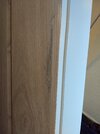After some advice please.
I've recently bought internal doors to fit new. Was steered away from a few that had minimal lippings and was recommended Déanta as they have 18mm each side. Magic as I've recently had a doorway moved in the bathroom and the width would have been touch and go with the smaller lips.
Anyway, I've fitted one with no hiccups but this door was slightly catching the door jam. So rather than repaint the frame, I've tried to relieve the door lipping and front. I've attached a photo what I'm left with.
Is there any way of recovering this? Oak filler maybe?
I've seen some techniques that uses a scalpel to recreate the grain which makes sense.
Not in the best of moods at the moment as you can probably imagine
Thanks for any help or advice
I've recently bought internal doors to fit new. Was steered away from a few that had minimal lippings and was recommended Déanta as they have 18mm each side. Magic as I've recently had a doorway moved in the bathroom and the width would have been touch and go with the smaller lips.
Anyway, I've fitted one with no hiccups but this door was slightly catching the door jam. So rather than repaint the frame, I've tried to relieve the door lipping and front. I've attached a photo what I'm left with.
Is there any way of recovering this? Oak filler maybe?
I've seen some techniques that uses a scalpel to recreate the grain which makes sense.
Not in the best of moods at the moment as you can probably imagine
Thanks for any help or advice


